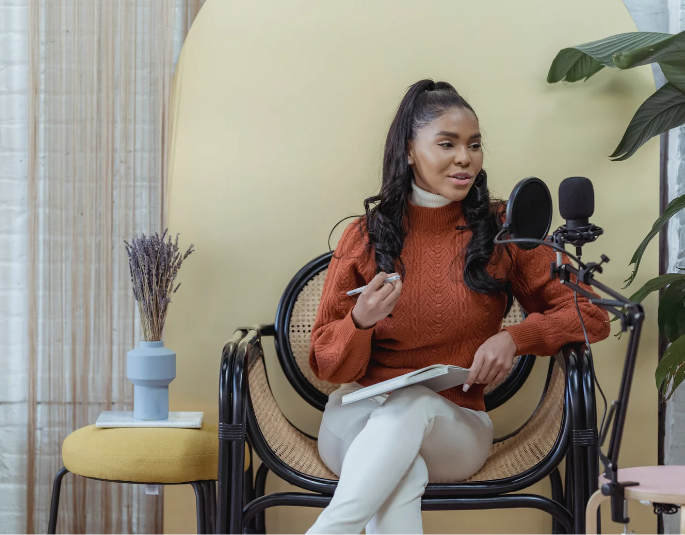In recent years, podcasts have exploded in popularity. From true crime to business advice to pop culture commentary, there seems to be a podcast for every interest and niche. But did you know that starting a podcast can also improve your life? Whether you’re looking to improve your communication skills, build your personal brand, or connect with others who share your interests, podcasting can offer a range of benefits. In this post, we’ll explore some of the ways that starting a podcast can improve your life and provide a step-by-step guide to getting started.
Step 1: Choose Your Podcast Topic and Format
The first step to starting a podcast is deciding what you want to talk about. Your topic should be something you’re passionate about and that you have knowledge or experience in. Once you’ve chosen your topic, it’s time to decide on a format. Do you want to do solo episodes or interview guests? Do you want to have a co-host or go it alone? There’s no right or wrong answer here, so choose a format that works for you.

Step 2: Get Your Podcasting Supplies
After you’ve decided on your topic and format, it’s time to get your podcasting supplies. Here’s a list of what you’ll need:
- Microphone: A good quality microphone is essential for recording clear audio. Some popular options include the Blue Yeti, Audio-Technica ATR2100x-USB, and Rode NT-USB.
Pop Filter: A pop filter is a screen that attaches to your microphone and helps to eliminate popping sounds when you speak. This is especially important if you’re recording vocals or spoken word content. (Customize your mic with your show name on the mic handle.) - Mic Stand or Boom Arm: A mic stand or boom arm is used to hold your microphone in place during recording. This allows you to adjust the height and distance of your microphone to get the best sound quality.
- Audio Interface: An audio interface is a device that connects your microphone to your computer and allows you to adjust the levels and quality of your recording. Some popular options include the Focusrite Scarlett Solo and PreSonus AudioBox.
- Headphones: A good pair of headphones allows you to monitor the audio quality of your recordings and ensure that you’re capturing the best sound possible. Closed-back headphones are recommended to prevent any sound leakage from being picked up by your microphone.
- Recording and Editing Software: There are many software options available for recording and editing your podcast. Some popular options include Audacity, GarageBand (for Mac users), and Adobe Audition.
- Computer: You will need a computer to run your recording and editing software, as well as to upload and distribute your podcast.
- Internet Connection: A stable internet connection is essential for uploading and distributing your podcast, as well as for conducting any remote interviews or collaborations.
- Hosting Service: A hosting service allows you to store and distribute your podcast to various platforms such as Apple Podcasts, Spotify, and Google Podcasts. Some popular hosting services include Buzzsprout, Podbean, and Anchor.
- Optional: A Quiet Recording Space: Ideally, you want to record in a quiet space with minimal background noise. If you don’t have access to a soundproofed room, you can try recording in a closet with clothes and blankets to dampen any echo.
Step 3: Record and Edit Your First Episode
Once you have your supplies, it’s time to start recording. Find a quiet space and start recording your first episode. You’ll want to experiment with microphone placement and settings to get the best possible sound quality. Once you’ve finished recording, it’s time to edit your episode. Cut out any mistakes or long pauses and add any music or sound effects you’d like.
Step 4: Distribute Your Podcast
Now that you’ve recorded and edited your first episode, it’s time to distribute it. You can do this by uploading it to a hosting service such as Buzzsprout, Podbean, or Anchor. These services will provide you with an RSS feed that you can submit to various platforms such as Apple Podcasts, Spotify, and Google Podcasts. Here are some tips for distributing your podcast:
- Create cover art for your podcast that is at least 1400 x 1400 pixels. This is the minimum requirement for most podcast platforms.
- Write a description of your podcast that includes your podcast name, a brief summary of what your podcast is about, and any relevant keywords or topics.
- Submit your RSS feed to various platforms such as Apple Podcasts, Spotify, and Google Podcasts. You can also promote your podcast on social media or by reaching out to other podcasters in your niche.
- Consistency is key! Try to stick to a regular schedule for releasing new episodes and engage with your listeners by responding to comments and feedback.

Step 5: Promote Your Podcast
Great your podcast is live, it’s time to start promoting it. Here are some tips for getting the word out:.
- Share your podcast on social media. Post about new episodes, behind-the-scenes glimpses, and any special promotions or events related to your podcast.
- Reach out to other podcasters in your niche. Collaborate on episodes, guest on each other’s shows, or just network and share tips and advice.
- Ask your listeners to leave reviews and ratings on platforms like Apple Podcasts. Positive reviews and high ratings can help your podcast climb the charts and attract new listeners.
Consider paid promotion through social media ads or other platforms
Step 6: Monitor and Improve Your Podcast
Since you’ve launched your podcast and started promoting it, it’s important to monitor its performance and continually improve it. Here are some things to keep in mind:
- Monitor your analytics to see how many downloads and listens your podcast is getting. This can help you see which episodes are most popular and which topics or guests your audience is most interested in.
- Take feedback from your listeners and adjust your content accordingly. Consider doing listener surveys or polls to get direct feedback.
- Keep learning and improving your craft. Listen to other podcasts, attend industry events, and stay up to date on the latest trends and techniques.
Starting a podcast can be a powerful way to improve your life. Whether you’re looking to build your personal brand, connect with others who share your interests, or improve your communication skills, podcasting can offer a range of benefits. By following the steps outlined in this guide, you can launch your own podcast and start reaping the rewards. Remember to stay committed to your podcast, promote it through social media and other channels, and continually seek feedback and opportunities for improvement. With time and effort, your podcast could become a platform for personal and professional growth, and a source of fulfillment and enjoyment in your life.

